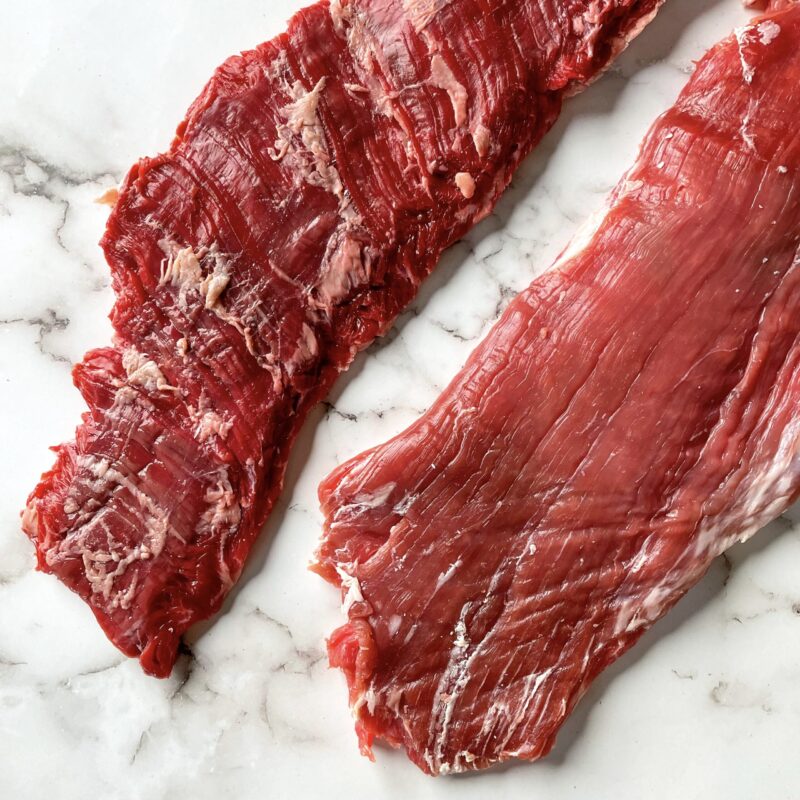When it comes to choosing between skirt steak and flank steak, culinary enthusiasts often find themselves torn between these two delicious and affordable cuts of beef. Skirt steak comes from the plate section below the rib of the cow, while flank steak is sourced from the flank area.
Both cuts offer deep, beefy flavors, making them popular choices for a wide range of dishes.
Key Takeaways:
- Skirt steak and flank steak are both flavorful and affordable cuts of beef.
- Skirt steak is longer, thinner, and richer in flavor compared to flank steak.
- Both cuts can be used interchangeably in most recipes.
- Skirt steak is often used for fajitas, tacos, and stir-fry dishes.
- Flank steak is commonly used for grilling and pan-searing.
Understanding Skirt Steak and Flank Steak
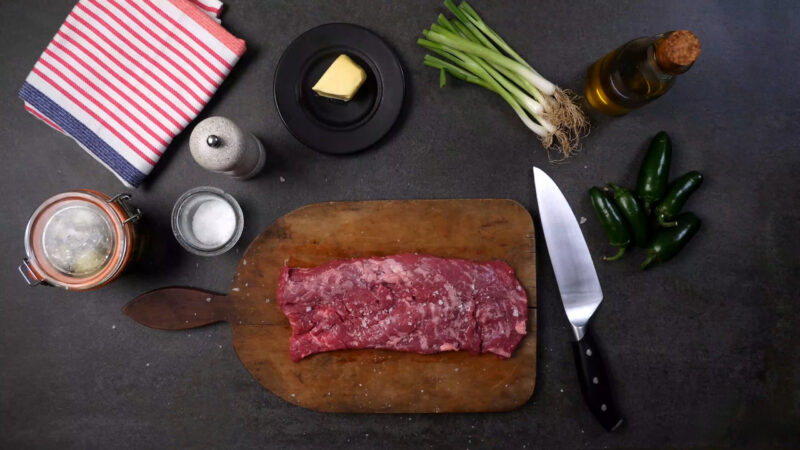
Skirt steak and flank steak, although different in some aspects, share a common origin in the cow’s anatomy. Skirt steak is obtained from the plate section below the rib of the cow, while flank steak comes from the flank area. The plate section is located between the brisket and the flank, and it is where the skirt steak is found. On the other hand, the flank area is the abdominal muscle of the cow.
Visually, skirt steak and flank steak have distinct appearances. Skirt steak is long, thin, and ribbon-like in shape. Its thinness offers a unique cooking challenge as it requires a shorter cooking time compared to the thicker flank steak.
Skirt steak has visible muscle fibers running parallel to its length, giving it a chewy texture that many people enjoy. On the other hand, flank steak is flat and oval-shaped, with muscle fibers running the length of the steak. Both cuts have a deep, beefy flavor that is highly prized in the culinary world.
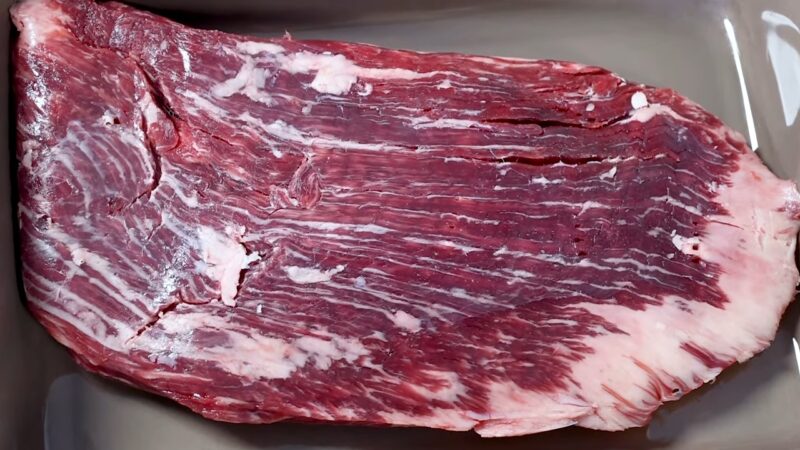
When it comes to versatility in the kitchen, both skirt steak and flank steak are excellent choices. They can be used interchangeably in most recipes, thanks to their similar flavors and textures. However, there are a few differences to consider.
Due to its thinness, skirt steak cooks faster than flank steak, requiring adjustments in cooking time. It is also recommended to marinate flank steak for a slightly longer period to enhance its tenderness. Additionally, both cuts should be sliced against the grain for maximum tenderness.
Comparing Skirt Steak and Flank Steak
| Skirt Steak | Flank Steak |
|---|---|
| Long, thin, and ribbon-like in appearance | Flat and oval-shaped |
| Visible muscle fibers | Muscle fibers running the length |
| Rich, beefy flavor | Deep, beefy flavor |
| Used for fajitas, tacos, and stir-fry dishes | Commonly used for grilling and pan-searing |
| Adjust cooking time due to thinness | Marinate for slightly longer time to enhance tenderness |
| Should be sliced against the grain | Should be sliced against the grain |
In the culinary world, skirt steak is often the go-to choice for fajitas, tacos, and stir-fry dishes, thanks to its unique texture and rich flavor. On the other hand, flank steak shines when it comes to grilling and pan-searing, making it a popular choice for steak enthusiasts.
Both cuts offer a delightful eating experience when prepared properly, so the choice between skirt steak and flank steak ultimately comes down to personal preference and the specific dish being prepared.
Exploring the Unique Flavors of Skirt Steak
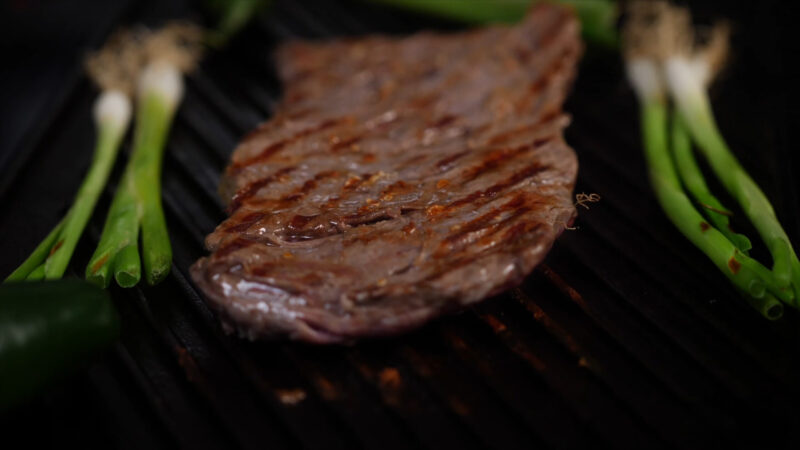
Skirt steak boasts an unmistakable and robust flavor that is unmatched by many other cuts of beef. Its rich beefy taste is a result of the cut’s unique composition and texture. Skirt steak comes from the plate section below the rib of the cow, and its long, thin, and ribbon-like appearance sets it apart from other cuts. The visible muscle fibers and distinctive chew contribute to its characteristic texture and mouthfeel.
This flavorful cut of beef has a taste profile that is often described as bold, juicy, and intense. Skirt steak’s rich flavor pairs well with a variety of seasonings and marinades, making it a versatile choice for different cuisines and cooking methods. Whether grilled, pan-seared, or stir-fried, skirt steak delivers a satisfying meaty experience that is sure to please the taste buds.
Skirt Steak Flavor Profile:
- Taste: Rich, bold, beefy
- Texture: Chewy, tender when cooked correctly
- Aroma: Savory, meaty
- Appearance: Dark, juicy
When preparing skirt steak, it is essential to keep in mind that the cut is thinner compared to other steaks. Therefore, it cooks relatively quickly and should be grilled or seared over high heat for a short period to achieve optimal flavor and tenderness. Slicing skirt steak against the grain after cooking further enhances its tenderness, ensuring a delightful eating experience.
| Cut | Flavor | Texture |
|---|---|---|
| Skirt steak | Rich, bold, beefy | Chewy, tender when cooked correctly |
| Flank steak | Deep, beefy | Tender, lean |
Skirt steak is a popular choice for dishes like fajitas, tacos, and stir-fries due to its strong flavor and ability to absorb and complement various seasonings. Whether you’re aiming for a mouthwatering Mexican feast or a sizzling Asian stir-fry, skirt steak is sure to deliver the rich and satisfying taste that many beef lovers crave. It’s no wonder that this cut has become a staple in many culinary traditions around the world.
Unveiling the Flavor Profile of Flank Steak:
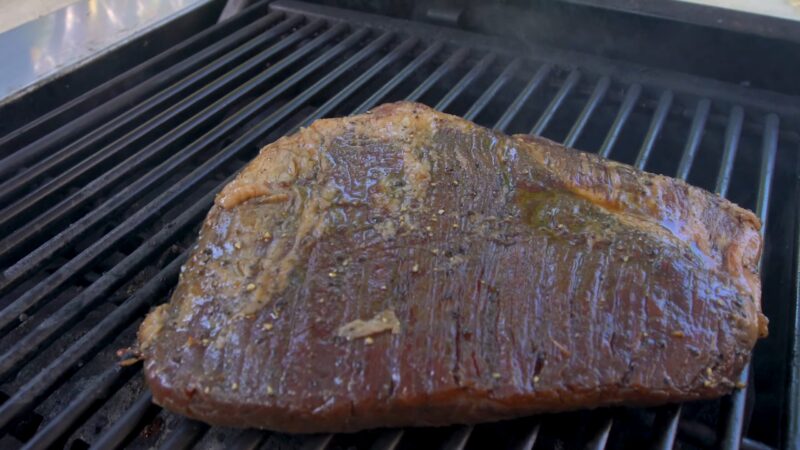
Flank steak is renowned for its deep and savory flavor that adds a delicious punch to any dish it is used in. This cut of beef boasts a rich taste that is often described as beefy, robust, and satisfying. With its distinctive flavor, flank steak can elevate the taste of various recipes, making it a popular choice among chefs and home cooks alike.
The Taste Profile of Flank Steak:
Flank steak is packed with the classic flavors associated with beef, offering a bold and meaty taste that lingers on the palate. The combination of marbling and lean muscle fibers in this cut contributes to its deep flavor and tender texture. When cooked properly, flank steak can become irresistibly juicy, providing a satisfying mouthfeel with every bite.
Whether it’s marinated, grilled, or pan-seared, flank steak retains its hearty flavor, making it the perfect choice for a range of culinary creations. From stir-fries to tacos, the robust taste of flank steak pairs well with a variety of spices, seasonings, and sauces, allowing for endless flavor possibilities.
| Flavor Profile | Description |
|---|---|
| Deep and Savory | The flavor of flank steak is rich, robust, and satisfying, delivering a deeply savory taste that stands out in any dish. |
| Beefy | With its meaty taste, flank steak captures the essence of beef, adding a distinct and satisfying flavor to recipes. |
| Tender | When cooked properly, flank steak becomes tender and juicy, providing a delightful texture that enhances the overall dining experience. |
It’s worth noting that the taste of flank steak can vary slightly depending on factors such as the animal’s diet, the cooking method used, and the seasoning applied. However, its deep and beefy flavor remains a constant, making flank steak a reliable choice for those seeking a delicious and satisfying beef experience.
Similarities Between Skirt Steak and Flank Steak
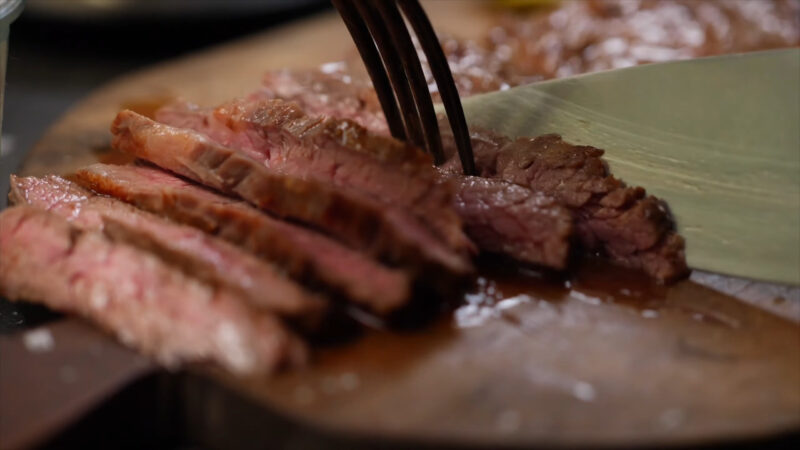
Skirt steak and flank steak share many similarities, making them versatile options for various culinary creations. Both cuts come from different sections of the cow, with skirt steak originating from the plate section below the rib and flank steak from the flank area. While their appearances differ, with skirt steak being long and thin, and flank steak flat and oval, they both have visible muscle fibers running through them.
When it comes to flavor, skirt steak and flank steak offer deep, beefy tastes that are sure to satisfy meat lovers. They are known for their rich and robust flavors, making them ideal choices for recipes that require a hearty beefy taste. Due to their similar flavors, skirt steak and flank steak can often be used interchangeably in dishes where tenderness is not the primary concern.
While cooking both cuts, it is important to slice against the grain to ensure maximum tenderness. This technique helps to break down the muscle fibers and prevent chewiness. Skirt steak and flank steak can be enjoyed in a variety of ways, including grilling and pan-searing. Their versatility allows for creativity in the kitchen, whether you’re making fajitas, tacos, stir-fry, or classic grilled dishes.
| Similarities Between Skirt Steak and Flank Steak |
|---|
| Both cuts have visible muscle fibers |
| Deep, beefy flavors |
| Can be used interchangeably in many recipes |
| Slicing against the grain for maximum tenderness |
| Versatile options for fajitas, tacos, stir-fry, grilling, and pan-searing |
Skirt steak and flank steak are two delicious options for beef lovers. While they have their differences, it’s clear that they share many similarities that make them both excellent choices for various culinary creations. Whether you choose skirt steak or flank steak for your next meal, you can’t go wrong with their deep, beefy flavors and versatility in the kitchen.
Key Differences to Consider
While skirt steak and flank steak are similar in many ways, there are a few notable differences that should be taken into account when working with these cuts of beef. Understanding these distinctions can help you make informed decisions about cooking methods and flavor pairings.
One key difference is the thickness of the two cuts. Skirt steak is thinner compared to flank steak, which means it cooks faster. When preparing skirt steak, it’s important to adjust your cooking time to prevent overcooking and maintain its tenderness. On the other hand, flank steak requires a slightly longer cooking time to achieve desired levels of doneness.
Marinating is another area where skirt steak and flank steak differ. Due to its thicker structure, flank steak benefits from a longer marinating time to help tenderize the meat and enhance its flavors. Skirt steak, with its already rich flavor, can benefit from a shorter marinating time or even a dry rub to avoid overpowering its natural taste.
Recommended uses also vary between the two cuts. Skirt steak shines in recipes that call for quick cooking methods such as grilling or stir-frying. Its thinness and robust flavor make it perfect for dishes like fajitas and tacos, where its natural taste can complement other ingredients.
Flank steak, with its thicker structure, is ideal for grilling and pan-searing. The longer cooking time allows the flavors to develop while maintaining the steak’s juiciness.
| Skirt Steak | Flank Steak |
|---|---|
| Thin cut | Thicker cut |
| Shorter cooking time | Longer cooking time |
| Rich, beefy flavor | Deep, beefy flavor |
| Versatile for grilling, stir-frying | Perfect for grilling, pan-searing |
Ultimately, the choice between skirt steak and flank steak depends on personal preference and the intended use. Both cuts offer delicious flavors and versatility, allowing you to create a wide range of mouthwatering dishes. Whether you prefer the thin and rich skirt steak or the thicker and beefier flank steak, experimenting with different recipes and cooking methods can help you discover your favorite.
Cooking Tips for Skirt Steak
To achieve the best results when cooking skirt steak, it’s essential to follow a few expert tips and techniques. Skirt steak is a flavorful and versatile cut of beef that can be grilled, pan-seared, or cooked in a stir-fry. Here are some cooking tips to ensure your skirt steak turns out tender and delicious:
- Marinate for Flavor: Skirt steak benefits from marinating to enhance its already rich taste. A simple marinade of olive oil, garlic, lime juice, and your favorite seasonings can work wonders. Let the skirt steak marinate for at least 30 minutes or up to overnight in the refrigerator before cooking.
- Preheat the Grill or Pan: Whether you’re grilling or pan-searing, it’s crucial to preheat your cooking surface. This helps to create a delicious crust on the outside of the skirt steak while keeping the inside juicy. Aim for medium-high heat on the grill or stovetop.
- Tenderize with a Fork: Skirt steak has visible muscle fibers, which can make it slightly tough if not prepared correctly. To tenderize the meat, use a fork to create small punctures on both sides of the steak. This technique allows the marinade to penetrate the meat and helps to break down any toughness.
- Quick Cooking: Skirt steak is thin, so it cooks quickly. Grill or sear it for about 3-4 minutes per side for medium-rare doneness. Be mindful not to overcook, as skirt steak can become chewy if cooked past medium.
- Slice Against the Grain: After resting the skirt steak for a few minutes, slice it thinly against the grain. This cutting technique helps to further tenderize the meat and ensures each bite is tender and easy to chew.
By following these cooking tips, you’ll be able to prepare skirt steak that is full of flavor and tender in every bite. Whether you’re grilling up some fajitas or adding it to a flavorful stir-fry, skirt steak is sure to impress.
| Cooking Tips for Skirt Steak | |
|---|---|
| Marinate for Flavor | Skirt steak benefits from marinating to enhance its already rich taste. Let it marinate for at least 30 minutes or up to overnight in the refrigerator before cooking. |
| Preheat the Grill or Pan | Ensure your cooking surface is preheated to medium-high heat for a delicious crust on the outside while keeping the inside juicy. |
| Tenderize with a Fork | Use a fork to make small punctures on both sides of the steak to help tenderize the meat and allow the marinade to penetrate. |
| Quick Cooking | Grill or sear the skirt steak for about 3-4 minutes per side for medium-rare doneness. Avoid overcooking to prevent chewiness. |
| Slice Against the Grain | After resting the skirt steak, thinly slice it against the grain to further tenderize the meat and ensure tenderness in each bite. |
Cooking Tips for Flank Steak
Mastering the art of cooking flank steak requires some tried-and-true techniques that can elevate your culinary creations.
- Marinating: Due to its thicker and leaner nature, flank steak benefits from marinating to enhance its tenderness and infuse it with flavors. Opt for acidic marinades that help break down the meat fibers, such as a combination of citrus juices, soy sauce, and herbs.
- Grilling: Flank steak is a popular choice for grilling due to its even thickness and ability to develop a charred crust. Preheat your grill to high and cook the steak over direct heat for about 4-6 minutes per side for medium-rare or until desired doneness. Remember to let it rest for a few minutes before slicing.
- Slicing against the grain: To ensure optimal tenderness, always slice flank steak against the grain. Look for the long muscle fibers running along the length of the steak and cut across them, resulting in shorter meat fibers and a more tender bite.
Here’s a table summarizing these cooking tips:
| Technique | Flank Steak |
|---|---|
| Marinating | Recommended for enhanced tenderness and flavor |
| Grilling | Perfect for developing a charred crust |
| Slicing against the grain | Ensures maximum tenderness |
With these cooking tips in mind, you’ll be able to prepare a delicious and tender flank steak that will impress your family and friends. Whether you’re grilling it for a summer barbecue or incorporating it into a flavorful stir-fry, the versatility of flank steak makes it a fantastic choice for various dishes.
Experiment with different marinades and cooking methods to find your favorite way to enjoy this flavorful cut of beef.
Popular Uses for Skirt Steak
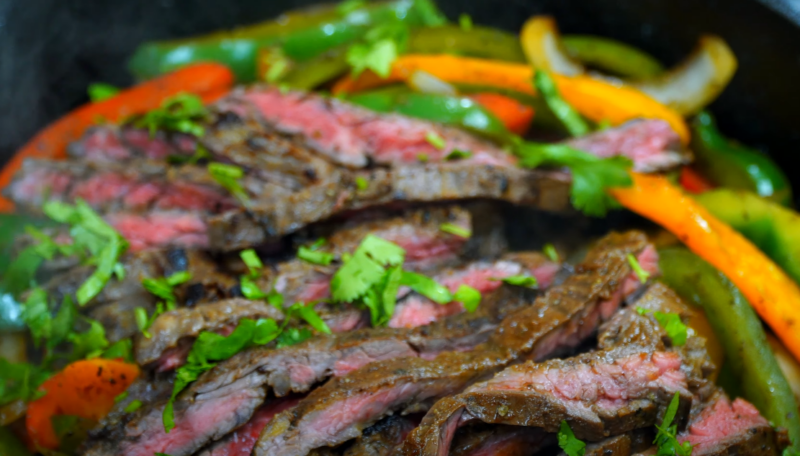
Skirt steak’s unique flavor and texture make it a superstar ingredient in several beloved dishes. Its rich, beefy taste and tender yet chewy texture lend themselves perfectly to a variety of culinary creations.
One popular use for skirt steak is in fajitas, where it is typically marinated and then grilled or pan-seared for a delicious and satisfying meal. The thinness of the cut allows for quick cooking, making it an ideal choice for this classic Mexican dish.
Another favorite way to enjoy skirt steak is in tacos. Whether served in soft corn tortillas or crispy shells, skirt steak adds a depth of flavor that pairs perfectly with traditional taco toppings like fresh salsa, guacamole, and cilantro. The versatility of skirt steak also makes it a fantastic choice for stir-fry dishes. The thin slices cook quickly and absorb the flavors of the stir-fry sauce, resulting in a delectable and savory meal.
When preparing skirt steak for these popular uses, it is important to slice the meat against the grain. This technique helps to break down the muscle fibers for maximum tenderness. By cutting across the grain, you ensure each bite is tender and easy to chew. Skirt steak’s ability to deliver exceptional flavor and versatility makes it a go-to choice for home cooks and professional chefs alike.
| Popular Uses for Skirt Steak | |
|---|---|
| Fajitas | Marinated, grilled or pan-seared, and served with sautéed onions and peppers for a flavorful Tex-Mex feast. |
| Tacos | Thinly sliced and served in tortillas with fresh toppings for a delicious handheld meal bursting with flavor. |
| Stir-fry | Quickly cooked with vegetables and savory sauces for a satisfying and flavorful Asian-inspired dish. |
So the next time you’re looking to elevate your cooking, consider incorporating skirt steak into your favorite recipes. Its unique flavor profile and versatility make it a standout choice for fajitas, tacos, stir-fry, and many other mouthwatering dishes. Whether you’re cooking for yourself, your family, or guests, skirt steak is sure to impress with its melt-in-your-mouth tenderness and robust beefy taste.
Recommended Uses for Flank Steak
Flank steak is a go-to choice for those seeking a tender and flavorful cut of beef for grilling or pan-searing. Its deep, beefy flavor pairs perfectly with these cooking methods, resulting in a delicious and satisfying meal. Here are some recommended uses for flank steak:
- Grilling: Flank steak is ideal for grilling due to its relatively thin profile and even thickness. Marinated or seasoned with your favorite flavors, a grilled flank steak can be a showstopper at any barbecue or outdoor gathering.
- Pan-searing: If grilling is not an option, pan-searing is a fantastic alternative. Searing the flank steak in a hot skillet locks in the juices and creates a flavorful crust on the outside while keeping the inside tender and juicy.
- Steak salads: Thinly sliced flank steak works wonderfully in salads, adding a burst of flavor and protein. Toss it with your favorite greens, vegetables, and dressings for a satisfying and nutritious meal.
- Stir-fry dishes: Sliced into thin strips, flank steak can be quickly stir-fried with a medley of vegetables, creating a delicious and healthy stir-fry. The flank steak’s rich flavor pairs well with the bold flavors of Asian-inspired sauces.
Remember, no matter how you choose to cook flank steak, it is essential to slice it against the grain. This technique increases tenderness and ensures a more enjoyable dining experience. So the next time you’re looking for a versatile and flavorful beef option, consider reaching for a succulent flank steak.
| Doneness | Temperature (Fahrenheit) |
|---|---|
| Rare | 125-130 |
| Medium-rare | 130-135 |
| Medium | 140-145 |
| Medium-well | 150-155 |
| Well done | 160+ |
Remember to use a meat thermometer to ensure your flank steak reaches your desired doneness. Let the steak rest for a few minutes after cooking to allow the juices to redistribute before slicing and serving. Whether you’re grilling, pan-searing, or incorporating flank steak into other dishes, its tenderness and flavor will elevate your culinary creations.
Skirt Steak vs Flank Steak: The Verdict
After carefully examining the characteristics and uses of both skirt steak and flank steak, it becomes clear that declaring a definitive winner between the two is a matter of personal taste and culinary intention.
Skirt steak, with its longer, thinner profile and rich flavor, is often favored for dishes like fajitas, tacos, and stir-fries. On the other hand, flank steak, with its flat and oval shape, is commonly used for grilling and pan-searing.
Both cuts offer deep, beefy flavors that can enhance a variety of recipes. Skirt steak’s distinct chew and pronounced taste make it a popular choice for those seeking a more indulgent eating experience. Flank steak, with its slightly milder flavor, is often marinated to enhance tenderness and juiciness.
When it comes to cooking, skirt steak requires less time due to its thinner nature, while flank steak benefits from a longer marinating period. Slicing both cuts against the grain is crucial for maximum tenderness.
In the end, the choice between skirt steak and flank steak boils down to personal preference and the dish being prepared. Whether you prefer skirt steak’s richness and versatility or the simplicity of flank steak’s grilling prowess, both cuts offer a delicious and economical option for beef lovers.
| Skirt Steak | Flank Steak |
|---|---|
| Elongated and thin | Flat and oval |
| Rich, beefy flavor | Deep, beefy flavor |
| Ideal for fajitas, tacos, stir-fries | Great for grilling, pan-searing |
| Less cooking time required | Longer marinating time suggested |
| Visible muscle fibers | Muscle fibers run the length of the steak |
FAQ
Can skirt steak and flank steak be used interchangeably in recipes?
Yes, skirt steak and flank steak can often be used interchangeably in recipes due to their similar flavors.
How should skirt steak be cooked?
Skirt steak is best cooked using high-heat methods such as grilling or pan-searing. It is also important to slice skirt steak against the grain for maximum tenderness.
How should flank steak be cooked?
Flank steak is commonly cooked by grilling or pan-searing. It is recommended to marinate flank steak for a slightly longer time to enhance its tenderness. Slicing against the grain is also important for optimal tenderness.
What are some popular uses for skirt steak?
Skirt steak is commonly used in dishes like fajitas, tacos, and stir-fries due to its rich flavor and versatility.
What are some recommended uses for flank steak?
Flank steak is often used for grilling and pan-searing, making it a great choice for steaks, sandwiches, and salads.
How should skirt steak and flank steak be sliced?
Both skirt steak and flank steak should be sliced against the grain, which helps to maximize tenderness and create a more pleasant eating experience.
What is the main difference between skirt steak and flank steak?
The main difference between skirt steak and flank steak is their physical appearance and cooking time. Skirt steak is longer and thinner, while flank steak is flatter and oval-shaped. Skirt steak also has a richer flavor compared to flank steak.
Final Words
Skirt steak, originating from the plate section below the rib, is thin and known for its rich flavor and chewy texture. Flank steak, from the cow’s flank area, has a deep beefy taste and a flat, oval shape.
Both cuts are flavorful, but skirt steak cooks faster, so it’s essential to adjust cooking times to avoid overcooking. Their versatility makes them ideal for a range of dishes, from fajitas to grilling.

